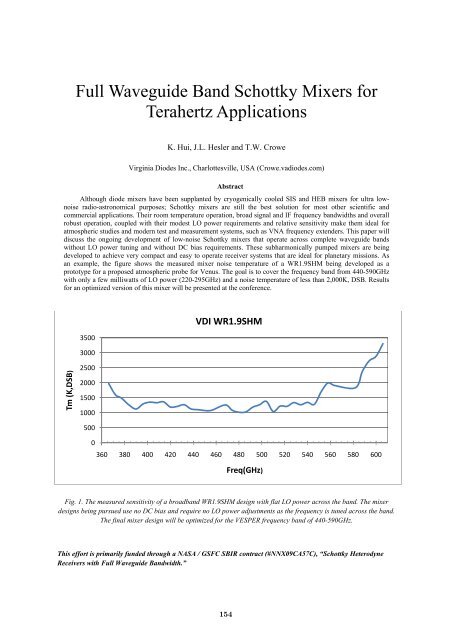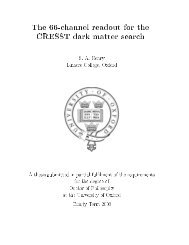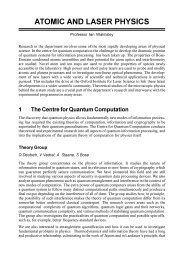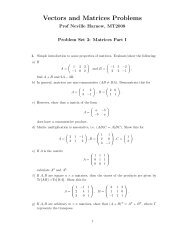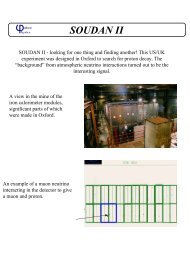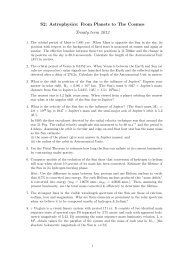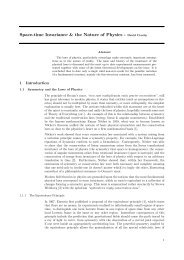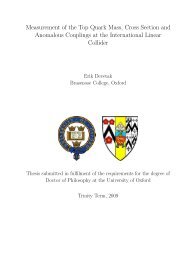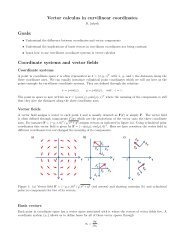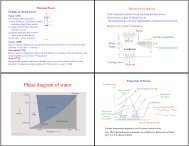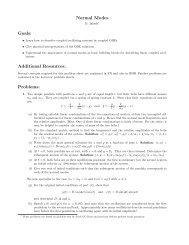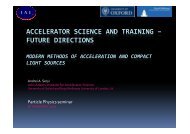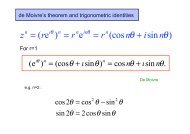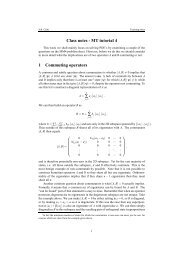Session S6: Schottky Diodes and Mixers - Department of Physics
Session S6: Schottky Diodes and Mixers - Department of Physics
Session S6: Schottky Diodes and Mixers - Department of Physics
Create successful ePaper yourself
Turn your PDF publications into a flip-book with our unique Google optimized e-Paper software.
Full Waveguide B<strong>and</strong> <strong>Schottky</strong> <strong>Mixers</strong> for<br />
Terahertz Applications<br />
K. Hui, J.L. Hesler <strong>and</strong> T.W. Crowe<br />
Virginia <strong>Diodes</strong> Inc., Charlottesville, USA (Crowe.vadiodes.com)<br />
<br />
Abstract<br />
Although diode mixers have been supplanted by cryogenically cooled SIS <strong>and</strong> HEB mixers for ultra lownoise<br />
radio-astronomical purposes; <strong>Schottky</strong> mixers are still the best solution for most other scientific <strong>and</strong><br />
commercial applications. Their room temperature operation, broad signal <strong>and</strong> IF frequency b<strong>and</strong>widths <strong>and</strong> overall<br />
robust operation, coupled with their modest LO power requirements <strong>and</strong> relative sensitivity make them ideal for<br />
atmospheric studies <strong>and</strong> modern test <strong>and</strong> measurement systems, such as VNA frequency extenders. This paper will<br />
discuss the ongoing development <strong>of</strong> low-noise <strong>Schottky</strong> mixers that operate across complete waveguide b<strong>and</strong>s<br />
without LO power tuning <strong>and</strong> without DC bias requirements. These subharmonically pumped mixers are being<br />
developed to achieve very compact <strong>and</strong> easy to operate receiver systems that are ideal for planetary missions. As<br />
an example, the figure shows the measured mixer noise temperature <strong>of</strong> a WR1.9SHM being developed as a<br />
prototype for a proposed atmospheric probe for Venus. The goal is to cover the frequency b<strong>and</strong> from 440-590GHz<br />
with only a few milliwatts <strong>of</strong> LO power (220-295GHz) <strong>and</strong> a noise temperature <strong>of</strong> less than 2,000K, DSB. Results<br />
for an optimized version <strong>of</strong> this mixer will be presented at the conference.<br />
VDIWR1.9SHM<br />
3500<br />
3000<br />
Tm(K,DSB)<br />
2500<br />
2000<br />
1500<br />
1000<br />
500<br />
0<br />
360 380 400 420 440 460 480 500 520 540 560 580 600<br />
Freq(GHz)<br />
<br />
Fig. 1. The measured sensitivity <strong>of</strong> a broadb<strong>and</strong> WR1.9SHM design with flat LO power across the b<strong>and</strong>. The mixer<br />
designs being pursued use no DC bias <strong>and</strong> require no LO power adjustments as the frequency is tuned across the b<strong>and</strong>.<br />
The final mixer design will be optimized for the VESPER frequency b<strong>and</strong> <strong>of</strong> 440-590GHz.<br />
This effort is primarily funded through a NASA / GSFC SBIR contract (#NNX09CA57C), “<strong>Schottky</strong> Heterodyne<br />
Receivers with Full Waveguide B<strong>and</strong>width.”<br />
154


